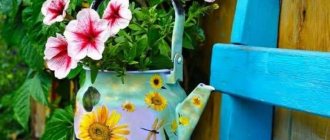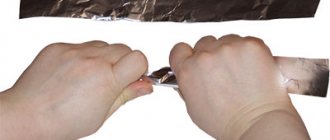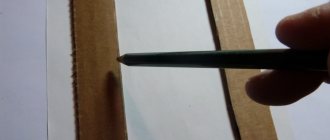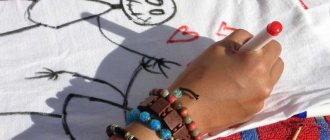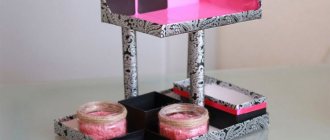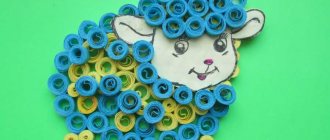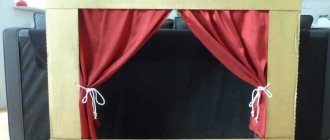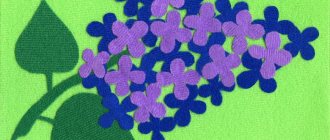How to work with glass?
Before making a glass craft, you need to familiarize yourself with the intricacies of the working process. Thanks to skills and knowledge, it is possible to create delightful and irresistible products.
What tricks will be needed to process the surface and side edges? Experts recommend following a few tips:
- To process large glasses you will need a special glass cutter.
- Thanks to this equipment, it is possible to carefully shape the side edges and cut out the necessary parts;
- To ensure that the edges are not sharp, they are sanded using sandpaper;
- To create a matte base, you will need to use a cleaning powder containing large granules;
- To create through holes, use a drill with a thin drill bit. However, the working surface is lubricated with a small amount of turpentine and rosin.
The drill must be operated at low speed. The mixture should evenly fill the recesses until a hole appears on the surface of the glass;
- To clean the surface you will need to use a vacuum cleaner. Thanks to it, it is possible to remove glass dust;
- Don't forget about safety precautions. Particular attention is paid to the eyes. To do this you will need clear glasses.;
- To paint glass surfaces, use a set of acrylic paints and yellow wax.
- The wax base is first dissolved in turpentine. Next, a drier is added to the liquid base.
- This substance allows you to increase the drying speed. Dry dyes can be added to the wax.
Methods for preparing silicate mixture
Despite the fact that the construction industry is developing very actively, the use of liquid glass is still popular to this day. Making liquid glass yourself is quite difficult, but quite possible. Since the material is practically not used as an independent substance, it is used in tandem with others (primer, cement). Let's look at several ways to prepare silicate material.
Soil mixture
It is impossible to work with a primer only with liquid glass, so they make a mixture. To make the mixture, only three components are required - water, cement and liquid glass:
- You should mix cement and an aqueous solution of silicate in a ratio of 1 to 1 (that is, 10 kg of cement + 10 kg of glass).
- Before mixing these two substances, it is necessary to dilute the cement with water.
Important! The main thing is to remember to constantly stir the mixture so that it does not thicken too much. If the primer still thickens, you can add a little water.
Fireproof coating
This composition is used for stoves and fireplaces in bathhouses. The silicate solution is added at the last stage of preparing the refractory mixture. Make the mixture in small portions so that it does not have time to dry out and thicken too much.
Waterproofing mixture:
- Diluted silicate material is added to dry cement in a ratio of 1 to 10 (that is, 1 kg of silicate glue to 10 kg of dry cement).
- The resulting mixture begins to thicken and harden in the first five minutes, so it is recommended to use it immediately.
Important! If the solution you have made has hardened, you can add a little water to it, but it is worth remembering that the waterproofing properties will deteriorate. However, one advantage remains unchanged - preventive effects against fungus and mold.
How to cut a glass bottle or tube?
To do this, it is recommended to adhere to certain actions:
- The upper part is carefully wrapped with paper tape.
- The pulp should adhere to the cut site.
- Next, use a lighter or candle to light the tape.
- At high temperatures, the glass base heats up quickly.
- To make a neat cut, you will need some cold water.
- Due to the temperature difference, the neck will burst neatly along the intended line.
Products using fusing technique
Such crafts are made from broken glass, the elements of which are carefully baked together. Externally, the finished products resemble stained glass panels.
The only nuance of this technique is the presence of a special oven. These devices are distinguished by their compact dimensions and affordable cost.
- To create a craft, you will need special colored glass, which can be purchased in specialized departments for hobbies and creativity.
- In the presence of ordinary fragments, novice craftsmen will need patience and perseverance.
- Finished products can be used as a gift or interior decoration.
- Such items are no different from store-bought goods.
Useful tips for preparing hydrous silicate:
- An aqueous silicate solution has become an excellent solution for protecting against dampness in basements and wells. For 1 kg of hydrous silicate, take 10 kg of concrete; the walls of basements and wells are treated with this composition.
- It is recommended to thoroughly stir the aqueous silicate composition with a brush or roller. The proportions of the components should be determined only after you have determined the purpose of using such a solution.
- If silicate is used as an additive in cement, be sure to stir the mixture constantly. After using the composition, wash your hands thoroughly in soapy water.
- If hydrous silicate gets on your skin, it is recommended to immediately treat the contaminated area with running water.
- If you decide to treat the walls with the composition, you will first have to level them and degrease them. To apply the substance, use a regular brush and spray gun. If you decide to make a more thorough and thick coating, apply several layers of the solution.
Important! Regardless of how you use hydrous silicate - in combination with other substances or on its own, always take precautions. Wear protective gloves, a mask and, if possible, special glasses.
Glass mosaic
We present to your attention a detailed master class on glass crafts at home. This needlework technique allows you to create unusual crafts without the use of special equipment and expensive consumables. To work you will need:
- Fragments of different diameters. To create, you can use glass of different shades, densities and textures;
- The image from which the product will be created;
- Transparent base;
- Silicone glue;
- Grout;
- Wire cutters;
- Glass cutter for processing large parts.
The workflow consists of several points:
- It is necessary to carefully transfer the image onto a transparent base, the outline of which will help to correctly distribute the colored elements. To do this, you can use a thin corrector. This way the lines will not be erased.
- Next, we proceed to preparing the colored parts. Using wire cutters, carefully break off the compact elements. Safety must be observed during work. To do this, it is recommended to use fabric gloves with a rubber base.
- Now you can move on to laying out individual sections of the glass pattern. Using silicone glue we will fix the workpieces on a transparent surface.
- Carefully fill the distance between the parts with grout.
- When it dries, remove excess with a damp cloth. The photo of the glass craft shows the finished product.
Characteristics and applications
Liquid glass is widely used in household and industrial areas. The popularity of the material is due to:
- High level of astringent properties and penetrating abilities.
- The widespread availability of initial components (sand, soda, potash, cullet) and their low cost. This makes the final product accessible and inexpensive. Sodium liquid glass costs from 16 rubles per kg, potassium glass - from 54 rubles per kg.
- Lack of toxicity both during production (including from recycled materials) and during use. Liquid glass is classified as “green chemistry” because it is environmentally friendly and safe.
- Absolutely non-flammable, no release of harmful substances when exposed to high temperatures.
- Low heat conductivity.
- The possibility of using it as soluble silica - there are no natural analogues .
Withstands high temperatures (up to 1200 o C). Liquid glass hardens at temperatures from 0 o C.
Liquid glass is used to create:
- silica gel;
- catalysts;
- adsorbents;
- lead silicate;
- sodium metasilicate;
- production of white soot;
- textile softener;
- zeolites;
- silica sol;
- organosiloxanes and other substances.
In addition, it is widely used for the production of :
- adhesives;
- paints;
- fire-retardant, protective, non-stick, anti-corrosion, anti-glare coatings;
- electrodes;
- as a component for strengthening primers;
- impregnating compositions for wood, paper, fabrics, construction products and other materials;
- agglomeration of ores.
By adding liquid glass to a variety of materials, you can increase them :
- strength;
- density;
- durability;
- abrasion resistance;
- fire-resistant and water-repellent properties;
- chemical inertness;
- corrosion resistance.
In addition, you can eliminate the appearance of mold, mildew and rot.
Main technical characteristics:
- density;
- silicate module;
- percentage of silica and metal oxides.
The silicate module indicates the adhesive ability of the material . The larger this value, the higher the ability. The product with module 2.6 - 3.6 is in greatest demand.
A frozen solution is a soft, jelly-like, thickened mass; after thawing, the properties return.
There may be sediment that does not affect the quality.
The disadvantages of the material include:
- incompatibility with brick surfaces - destruction occurs;
- fragility when used in pure form - combination with other substances is necessary;
- very fast setting - a cement mixture with the addition of liquid glass, depending on the concentration of the latter (2 - 10%) begins to harden within 5 - 50 minutes);
- alkaline nature - work should be carried out in protective clothing; Avoid contact with skin or eyes.
Crafts from glass bottles
Ordinary glass bottles can be given a second life. You can decorate the glass surface using acrylic paints, mosaic techniques, and available materials.
- For painting, special acrylic dyes are used, which dry quickly after application and do not deform during use. To work, use a set of brushes that allow you to adjust the thickness of the bright line. At the end of the work process, the decorative surface is coated with transparent furniture varnish.
- To make the surface more textured, use a sponge, twine, or silicone glue. The relief can also be painted in any color or left unchanged.
- To make a product using the mosaic technique, you can use small-diameter glass shards, small stones, shells, beans and peas. The distance between the elements is covered with putty.
- The glass base is first degreased to increase the adhesion of the decorations. After this, experts recommend painting the bottle a uniform color. Silicone glue is used to fix decorative parts.
- The distance between the parts is covered with putty. The consistency of the working solution should be similar to thick sour cream. The drying time for each layer is one hour. During this time, the putty will be able to evenly fill the voids.
- The final stage will be painting the decorative layer with acrylic paint. To add bright notes to the design of the product, you need to use several shades. Decorated bottles can be used as an interior vase or a stylish accessory.
